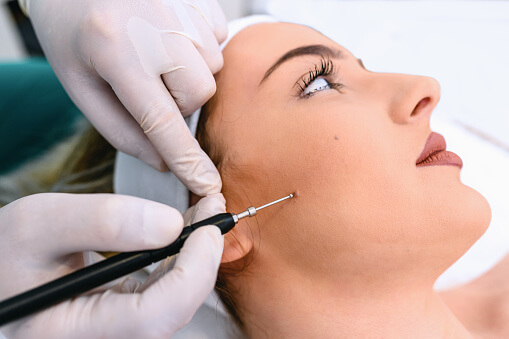Our skin is the most sensitive part of the body. Skin needs a proper care routine that helps keep it healthy and glowing and helps prevent skin problems. But what about genetic skin issues? Several skin conditions are widespread and benign (non-cancerous). These conditions include benign lentigines, seborrheic keratoses, moles, freckles, skin tags, and freckles. Skin tags and all these skin lesions are very common and normal among people.
Skin tags are tiny, benign growths that develop as a result of friction between the skin and itself. Typically, they don’t need to be treated. However, if their presence concerns you, you can have them removed. It’s crucial to get medical attention from a qualified professional rather than attempting to treat them yourself. Acrochordon, cutaneous papilloma, cutaneous tag, fibroepithelial polyp, fibroma molluscum, fibroma pendulum, soft fibroma, and Templeton tags are some of the further names for these lesions. they are extremely prevalent and typically appear after midlife. Both men and women are equally impacted by these serious skin issues.
Let us have a look at how skin tags occur on your body. Is there any medical or home treatment that can help in eliminating them? What exactly is it on your body?
Table of Contents

A skin tag is a little tissue flap that hangs from the skin on a stalk. Collagen, a type of protein, and the surrounding skin and blood vessels make up skin tags. Typically, they are located in the folds of the skin, such as the armpits, thighs, groin, eyelids, neck, and beneath the breasts. They frequently protrude from the skin’s surface on fleshy stalks or peduncles. They typically have a flesh tone or a light brown tint.
Skin tags are frequent, particularly as people get older. Although they are harmless, you should consult your doctor about having a skin tag removed if it is irritating you. They typically don’t exceed 2mm in size, but they have the potential to do so. They have a soft texture and might be wrinkly and uneven, smooth and spherical, or resemble a grain of rice. They can be deeper, sometimes even dark blue, or flesh-colored.
Usually, skin tags do not produce any symptoms. In certain instances, irritation or bleeding might result from a skin tag rubbing against your skin, clothing, or jewelry. If a mass of skin tissue is growing from a little stem then know that it is a skin tag. They can occasionally be darker and resemble a raised mole. You can see the excess skin growth range the size from 1 to 5 mm, although some can reach a few centimeters too.
While the specific cause of skin tags is unknown, doctors think that aging and excessive friction are the most likely to blame. The growths typically appear when clothing brushes or rubs against the skin. Additional elements that may raise your risk of getting skin tags include:
- Alterations in hormones during pregnancy
- Human papillomavirus (HPV) infection
- Insulin resistance linked to diabetes
- Because it frequently runs in families, according to experts, who also think genetics may be involved.
- individuals who are obese and/or overweight
- individuals with an imbalance in sex hormones, particularly if there are changes in
- estrogen and progesterone level
- obesity
- For instance, dyslipidemia causes high cholesterol levels
- High blood pressure or hypertension

Treatments
In most cases, they do not need to be treated unless they are painful or unsightly. In the event that you decide to have a skin tag removed, your physician will probably employ one of the following techniques:
- Utilizing a sharp object to cut them
- It can be treated using liquid nitrogen to freeze
- Ti also can be removed by current-driven flames burning
The majority of operations don’t require anesthesia, but if your tags on the skin are really large or if you’re having several skin tags removed, your doctor may administer lidocaine injections or an anesthetic lotion. It can take a few days for your skin tag to fall off if your doctor freezes or burns it. While there is no proof that removal encourages the growth of additional tags on the skin, there is no assurance that they won’t come back.
Skin tags are almost always benign, despite the fact that they may raise concerns. Very rarely, a skin tag may develop malignant or precancerous characteristics. A biopsy may be performed to rule out cancer risk if a skin tag bleeds, keeps expanding, or shows different colors. Tags on the skin can occasionally be confused with warts, moles, or other types of growths. The precise reason for your skin irregularity can be ascertained by your doctor or dermatologist. You can also speak with an ophthalmologist if the growth is close to your eye.

Should I try to remove my own Skin Tag?
Although some people are able to remove their tags on the skin at home, it is not advised owing to the possibility of bleeding and infection. Visit your doctor or dermatologist for a medical evaluation if you have any concerns about the anomalies on your skin.
As we already mentioned above that your doctor won’t allow you to treat the tags on your skin yourself at home. But if it is done correctly by following the guidance you can do it by yourself. Gently place a cotton swab over the skin tag after soaking it in apple cider vinegar to remove the tags. After covering the area with a bandage for 15 to 30 minutes, cleanse the skin. Repeat each day for a few weeks. Apple cider vinegar helps to dissolve the skin tag’s surrounding tissue without any side effects.
6 Useful Home Remedies for Pores
How to clean scalp pores naturally?
What is Dermaplaning? Side Effects, Pros, Costs
9 Benefits of Dermaplaning your Face
